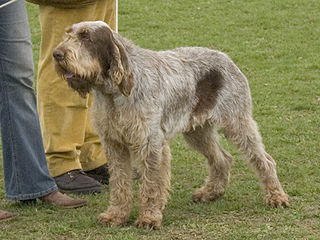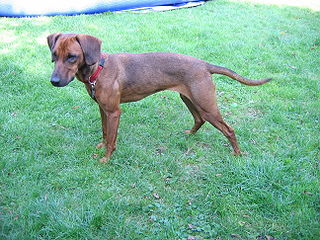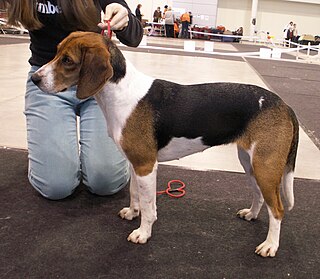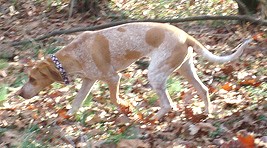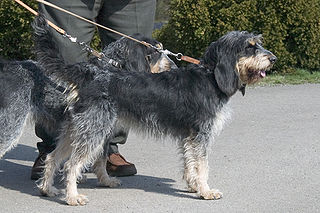This article needs additional citations for verification .(July 2013) (Learn how and when to remove this template message) |
The Piccolo Segugio dell'Appennino is a small hound that is relatively common along the Apennine mountain range of Italy. It is a variety of the Segugio dell'Appennino.

A hound is a type of hunting dog used by hunters to track or chase prey.

Italy, officially the Italian Republic, is a European country consisting of a peninsula delimited by the Italian Alps and surrounded by several islands. Located in the middle of the Mediterranean sea and traversed along its length by the Apennines, Italy has a largely temperate seasonal and Mediterranean climate. The country covers an area of 301,340 km2 (116,350 sq mi) and shares open land borders with France, Slovenia, Austria, Switzerland and the enclaved microstates of Vatican City and San Marino. Italy has a territorial exclave in Switzerland (Campione) and a maritime exclave in the Tunisian Sea (Lampedusa). With around 60 million inhabitants, Italy is the fourth-most populous member state of the European Union.
Segugio dell'Appennino or Piccolo Lepraiolo Italiano is a small Italian scenthound specifically bred to hunt hares.
Contents
This hound stands at most 48 centimetres to the withers and is found both with smooth and rough coats. It is mostly used for hunting hares, although it can occasionally hunt wild boar as well.

The withers is the ridge between the shoulder blades of an animal, typically a quadruped. In many species, it is the tallest point of the body. In horses and dogs, it is the standard place to measure the animal's height. In contrast, cattle are normally measured to the top of the hips.

Hares and jackrabbits are leporids belonging to the genus Lepus. Hares are classified in the same family as rabbits. They are similar in size and form to rabbits and have similar herbivorous diets, but generally have longer ears and live solitarily or in pairs. Also unlike rabbits, their young are able to fend for themselves shortly after birth rather than emerging blind and helpless. Most are fast runners. Hare species are native to Africa, Eurasia, North America, and the Japanese archipelago.

The wild boar, also known as the wild swine, Eurasian wild pig, or simply wild pig, is a suid native to much of Eurasia, North Africa, and the Greater Sunda Islands. Human intervention has spread its distribution further, making the species one of the widest-ranging mammals in the world, as well as the most widely spread suiform. Its wide range, high numbers, and adaptability mean that it is classed as least concern by the IUCN and it has become an invasive species in part of its introduced range. The animal probably originated in Southeast Asia during the Early Pleistocene, and outcompeted other suid species as it spread throughout the Old World.
The Società Italiana Pro Segugio (Italian Association for Scenthounds) gathered 1450 specimens of this dogs in the year 2000 by scouring the Italian countryside and registered a total of 824 dogs as breed founders, thus guaranteeing ample genetic variability within the breed. Most dog breeds are derived by a very small number of founders (for example just 9 dogs were used as founders during the creation of the Siberian Husky) and therefore inbreeding tends to be high, resulting in a high incidence of illness due to gene mutations. [1] The breed was eventually recognized by ENCI, the Italian kennel Club.
A breed is a specific group of domestic animals having homogeneous appearance (phenotype), homogeneous behavior, and/or other characteristics that distinguish it from other organisms of the same species. Breeds are formed through genetic isolation and either natural adaptation to the environment or selective breeding, or a combination of the two. Despite the centrality of the idea of "breeds" to animal husbandry and agriculture, no single, scientifically accepted definition of the term exists. A breed is therefore not an objective or biologically verifiable classification but is instead a term of art amongst groups of breeders who share a consensus around what qualities make some members of a given species members of a nameable subset.
Genetic variability is either the presence of, or the generation of, genetic differences.
The standard is as follows
- Small hound, a specialist for hunting hare.
- Height at withers: males 42–46 cm. Females 40–44 cm
- Mesocephalic head, whose length is 4,5/10 of the dogs height at the withers. The skull is a little longer than the muzzle, with the top being slightly convex
- The trunk can be inscribed in a rectangle
- The croup is angled at most 25°.
- Rough or smooth coat which can be brown, black and tan or grey
- Triangular ears with a large base, the ears have a rounded point.

The skull is a bony structure that forms the head in vertebrates. It supports the structures of the face and provides a protective cavity for the brain. The skull is composed of two parts: the cranium and the mandible. In humans, these two parts are the neurocranium and the viscerocranium or facial skeleton that includes the mandible as its largest bone. The skull forms the anterior most portion of the skeleton and is a product of cephalisation—housing the brain, and several sensory structures such as the eyes, ears, nose, and mouth. In humans these sensory structures are part of the facial skeleton.

A snout is the protruding portion of an animal's face, consisting of its nose, mouth, and jaw. In many animals, the equivalent structure is called a muzzle, rostrum, or proboscis. The wet furless surface around the nostrils of the nose of some animals is called the rhinarium. The rhinarium is often associated with a stronger sense of olfaction. The snout is considered a weak point on most animals: because of its structure, an animal can be easily stunned or knocked out, or even have its snout snapped by applying sufficient force.
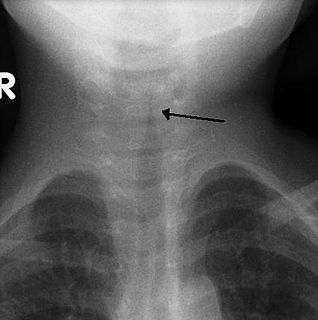
Croup, also known as laryngotracheobronchitis, is a type of respiratory infection that is usually caused by a virus. The infection leads to swelling inside the trachea, which interferes with normal breathing and produces the classic symptoms of "barking" cough, stridor, and a hoarse voice. Fever and runny nose may also be present. These symptoms may be mild, moderate, or severe. Often it starts or is worse at night. It normally lasts one to two days.
Of the utmost importance in the selection of this dog was its ability to hunt.

